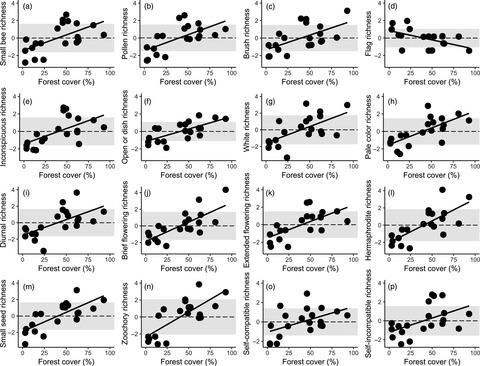Our official English website, www.x-mol.net, welcomes your
feedback! (Note: you will need to create a separate account there.)
The loss of functional diversity: A detrimental influence of landscape‐scale deforestation on tree reproductive traits
Journal of Ecology ( IF 5.3 ) Pub Date : 2019-07-10 , DOI: 10.1111/1365-2745.13232 Larissa Rocha‐Santos 1 , Margaret M. Mayfield 2 , Ariadna V. Lopes 3 , Michaele S. Pessoa 1, 4 , Daniela C. Talora 1 , Deborah Faria 1 , Eliana Cazetta 1
中文翻译:

功能多样性的丧失:景观尺度森林砍伐对树木繁殖性状的有害影响
更新日期:2019-07-10
Journal of Ecology ( IF 5.3 ) Pub Date : 2019-07-10 , DOI: 10.1111/1365-2745.13232 Larissa Rocha‐Santos 1 , Margaret M. Mayfield 2 , Ariadna V. Lopes 3 , Michaele S. Pessoa 1, 4 , Daniela C. Talora 1 , Deborah Faria 1 , Eliana Cazetta 1
Affiliation

|
- Agricultural activities such as crop production and cattle ranching are rapidly replacing forests worldwide, especially in the tropics. Resulting forest loss can adversely affect biodiversity in many ways, including trajectories of community reassembly, community composition, forest structural profiles and taxonomic diversity. Yet, effects of forest loss on specific ecosystem functions remain limited. Processes closely linked with tree reproduction, such as pollination and seed dispersal are of paramount importance for many ecological functions in tropical forests. Disruption in these processes is known to delay or change forest regeneration, diversity and structural dynamics.
- To explore how reproductive and dispersal traits are being altered by landscape‐scale deforestation, we surveyed and compiled trait data for tree communities in 20 tropical Atlantic rainforest remnants in northeastern Brazil, across a gradient of deforested landscapes, each retaining 3%–93% forest cover.
- The functional richness of reproductive plant attributes decreased as the amount of forest cover decreased, while divergence increased along the same gradient. Loss of forest cover disproportionately affected certain dispersal and reproductive attributes, with most heavily impacted functional attributes including: brief flowering duration, hermaphrodite sexual system, and zoochoric dispersal mode. We identified a clear threshold at 25–30% of forest cover, below which, reproductive attributes disappeared more quickly than expect from forest remnants.
- Synthesis. Deforestation may impair tree community functional diversity, particularly by decreasing the number of functions. Under scenarios of extensive deforestation, changes to reproductive and dispersal trait profile of forest communities suggest that profound modifications in the availability of floral and seed resources are likely to be substantial. Such extensive changes to food supply of pollinating and dispersing animals suggest carry‐over effects to the fauna of these important forest systems.
中文翻译:

功能多样性的丧失:景观尺度森林砍伐对树木繁殖性状的有害影响
- 诸如作物生产和牧场放牧等农业活动正在迅速取代全世界的森林,特别是在热带地区。造成的森林流失可能在许多方面对生物多样性产生不利影响,包括社区重组的轨迹,社区组成,森林结构概况和生物分类多样性。然而,森林流失对特定生态系统功能的影响仍然有限。与树木繁殖密切相关的过程,例如授粉和种子传播,对于热带森林的许多生态功能至关重要。众所周知,破坏这些过程会延缓或改变森林的再生,多样性和结构动力学。
- 为了探索景观尺度的森林砍伐如何改变生殖和传播特征,我们调查和汇编了巴西东北部20种热带大西洋雨林残余物中树木群落的特征数据,遍及森林砍伐景观的梯度,每片保留了3%–93%的森林覆盖。
- 随着森林覆盖量的减少,生殖植物属性的功能丰富性下降,而沿着相同的梯度发散则增大。森林覆盖率的丧失不成比例地影响了某些传播和生殖属性,其中影响最大的功能属性包括:短暂的开花期,雌雄同性的性系统和人畜共患的传播方式。我们确定了一个明确的阈值,即森林覆盖率的25%至30%,低于该阈值时,生殖属性的消失速度比森林残余物的消失速度要快。
- 综合。砍伐森林可能会损害树木群落的功能多样性,特别是减少功能数量。在大规模森林砍伐的情况下,森林群落生殖和传播性状特征的变化表明,花卉和种子资源的可利用性将发生重大变化。授粉和分散动物粮食供应的如此广泛的变化表明对这些重要森林系统的动物具有结转影响。











































 京公网安备 11010802027423号
京公网安备 11010802027423号